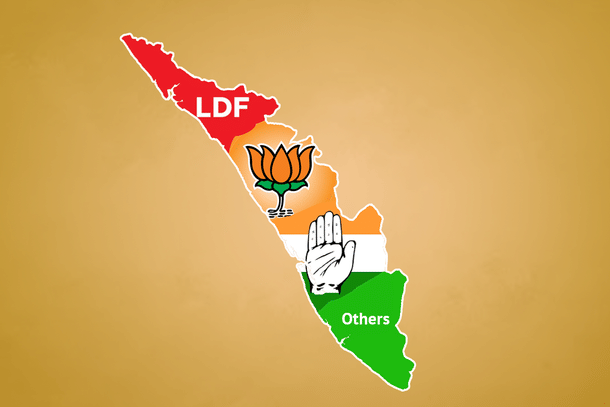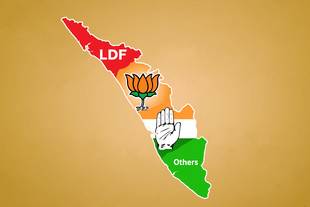Politics
Kerala Election Scenario: A Forecast
Venu Gopal Narayanan
Mar 28, 2021, 02:13 PM | Updated 02:13 PM IST
Save & read from anywhere!
Bookmark stories for easy access on any device or the Swarajya app.


The findings of over half a dozen opinion polls in Kerala indicate that Chief Minister Pinarayi Vijayan’s Left Democratic Front (LDF) will retain their popular mandate, with 75-80 seats and 41-43 per cent of the vote share.
The Congress-led United Democratic Front (UDF) under Oommen Chandy is expected to win 55-60 seats with 37-38 per cent of the vote share.
The National Democratic Alliance (NDA) of the Bharatiya Janata Party (BJP) and their Ezhava OBC ally, the Bharat Dharma Jana Sena (BDJS), could win three seats with 16-17 per cent of the popular vote.
There is a lot of heartburn in Kerala over these surveys.
The communists say they will cross 90 seats; the BJP says they will touch double digits; and anguished Congress supporters say that it will either be an Oommen Chandy cabinet once more, or a hung assembly.
So, how realistic are these forecasts and opinions, and to what extent do they represent the actual socio-political dynamics of the state?
Numerically, there is a very low probability for a hung assembly with the prevailing vote split, because for that, the BJP would need to touch close to twenty seats; and that is possible only if the BJP’s vote share goes up to the 22-24 per cent mark.
Also numerically, a Congress win would be contingent upon a tie-up between the LDF, and the Christian Kerala Congress (KEC) of Jose K Mani, failing completely (meaning that the Christian vote rejects the tie-up, and somehow votes en masse for the UDF).
But that is not what the surveys are saying, and that is not what the voters said, when they handed the LDF and their new ally, the KEC, a veritable sweep in the 2020 December local body polls.
Further, even if one were to generously assume, without basis, that the LDF lost half of the twenty-odd close contests in the state, it would still not be enough for the UDF to cross the halfway mark of 70, for two reasons.
One, that would get the UDF only to about 65 at best, and second, half a dozen of those close contests are actually not between the LDF and the UDF, but between the LDF and the BJP.
Therefore, ceteris paribus, the higher probability is that the LDF will be the largest grouping, and at least a handful of seats above the midway line.
Regarding the extent to which such predictions mirror the prevailing socio-political linkages in Kerala, we see that these are actually brought out quite representatively by the numbers.
Boiled down, the bitter truth is that Kerala has had, for many decades now, simply the most polarised electorate in the country. No one talks about it other than the BJP, but the reality is that selected communities are so symbiotically linked to their political outfits of sole choice (and indeed of their creation), that any and all issues of mis-governance, maladministration, or even criminal culpability, are forcefully reduced to, and subsumed by, such prodigious orchestrations of identity politics.
It is as if Sabarimala is in the Caucuses, as if a containment of the Wuhan virus epidemic wasn’t dangerously bungled with catastrophic consequences, that gold smuggling doesn’t take place in Kerala, or, that the disastrous handling of the 2018 floods was by someone other than the present communist dispensation.
It was, of course, the same when the Congress was at the helm: a mountainous fiscal deficit could be created without a whimper, femme fatales could sashay into the Secretariat like it was their own private boudoir, bridges were built with inadequate cement, and sex scandals quietly melted away like the ice cream of the parlours those crimes took place in.
Underlying this clubby coziness is a network of carefully-crafted, and well-established politico-economic linkages, which cuts to the core of whatever meagre commercial activity takes place in the state.
In Kerala, identity politics is a going concern; it is profitable; it offers strength in numbers; it is patently visible in everything ranging from manpower supply to the Gulf, to spices, to cashew, to government contracts; and vitally, it provides a hold over the electorate. (The ease with which a certain, prominent mall group procures land in the plushest of locales, receives approvals, pursues construction, and conducts operations with nil hindrances, is a popular case in point).
That is the reason why such strong efforts are on, to keep the BJP out of the Keralite political space at all costs.
The new entrant is seen as an existential threat to traditional patterns of commerce. No one wants their rice bowls broken. The threat to secularism is only incidental.
This is why we see a current trend of parties actually growing stronger in their traditional citadels (as Jai Mrug of VMR observed), once the BJP started expanding from the fringe to the main.
To that end, it must be admitted that Pinarayi Vijayan has played a very smart game indeed: he fatally split the UDF’s Christian vote bank right down the middle, by aligning with the Kerala Congress of Jose K Mani.
He got Kanam Rajendran, Kerala head of the Communist Party of India (CPI), to play the caste card in a piously-legalistic manner, by gingerly crossing swords with the Nair Service Society over the Sabarimala issue; its effect was to remind the core Ezhava vote where their future lay – with the Left.
He saw to it that his Finance Minister, Thomas Isaac, was denied a ticket.
Spin doctors may call this a retirement, but the move was actually made to prevent the Hindu vote from deserting the communists; whether the Left will admit it openly in public or not, Isaac was dumped to mollify those who saw red (pun not intended), after he called the Vamana avatar of Vishnu a cheater last year.
He even got his party secretary-in-charge, A Vijayaraghavan, to launch a blistering attack on the Muslim League, for purportedly facilitating an alliance between the Congress and the radical, Islamist Jamaat-e-Islami.
At the same time, LDF Power Minister MM Mani said that the IUML was not the official custodian of Muslims; that in fact, it was the Left which had protected them.
That was of course nothing but code, for who was more capable of taking on the big, bad BJP, and it should get the communists a few extra seats.
This has hurt the Congress, and bolsters the view that it is slowly-but-surely getting squeezed between the BJP and the Left. As it is, the Congress had gradually reduced itself to a Muslim-Christian party, following the departure of its core Nair vote to the BJP over the past decade.
All it is left with now is an embarrassing display of Hindu tokenism, via thick-skinned remnants like Ramesh Chennithala. And for all practical purposes, with the shift of the Christian KEC to the Left, the Congress in Kerala is now primarily a Muslim party, and a prostrate subset of the Indian Union Muslim League (IUML).
This is what the Congress has degenerated to in Kerala, where the probability of a Hindu Congress candidate winning in a Hindu majority seat, is declining inexorably with each passing election. The numbers speak for themselves: 34 of the 47 UDF winners in 2016 – a full 70 per cent – were Christians and Muslims. Their win ratio was around 50 per cent.
Conversely, only 10 Hindu general category candidates won on a UDF ticket, out of 53 who contested. That is a win ratio of under 20 percent.
Also, pertinently, 10 on 47 means that barely one in five UDF MLAs is a Hindu. And of those, the bulk only won because an IUML diktat gave them the Muslim vote, and the winning lead (examples include Thrithala, Wadakkanchery and Paravur seats, inter alia).
No wonder then, that Congress cadres, including seniors like Bindu Krishna (candidate for Kollam city seat), are so eagerly inclined to conduct festivals of beef bravado; it’s the tacit concordat between the power of the Muslim bloc vote, and a strengthening of its isolationist identity.
No wonder either, then, that the Hindu UDF candidate for Kongad SC reserved seat (which is in fact dominated by Muslims) is running on an IUML ticket. The irony is that this move is being spun to the public as a secular cap-doff to ‘Jai Meem Jai Bhim’.
Indeed, the final irony is that in this election, it is the BJP which is seeking votes beyond the state’s traditionally-rigid electoral lines of caste, religion and class.
So must we set the findings of multiple surveys aside, and ask a fundamental question: can the Congress come to power in Kerala without the Hindu vote?
The answer is ‘no’.
Thus, in conclusion, a representative, probabilistic assessment is that the Left will be returned for a second term via a splitting of the Christian vote, the electorally-decisive relevance of the Muslim vote will reduce, the BJP will grow at the UDF’s expense, and Swarajya’s prediction from five years ago will hold true – that Oommen Chandy will have been the last Congress Chief Minister of Kerala.
Those who live by the sword of identity politics are eventually doomed to be felled by it.
Venu Gopal Narayanan is an independent upstream petroleum consultant who focuses on energy, geopolitics, current affairs and electoral arithmetic. He tweets at @ideorogue.




